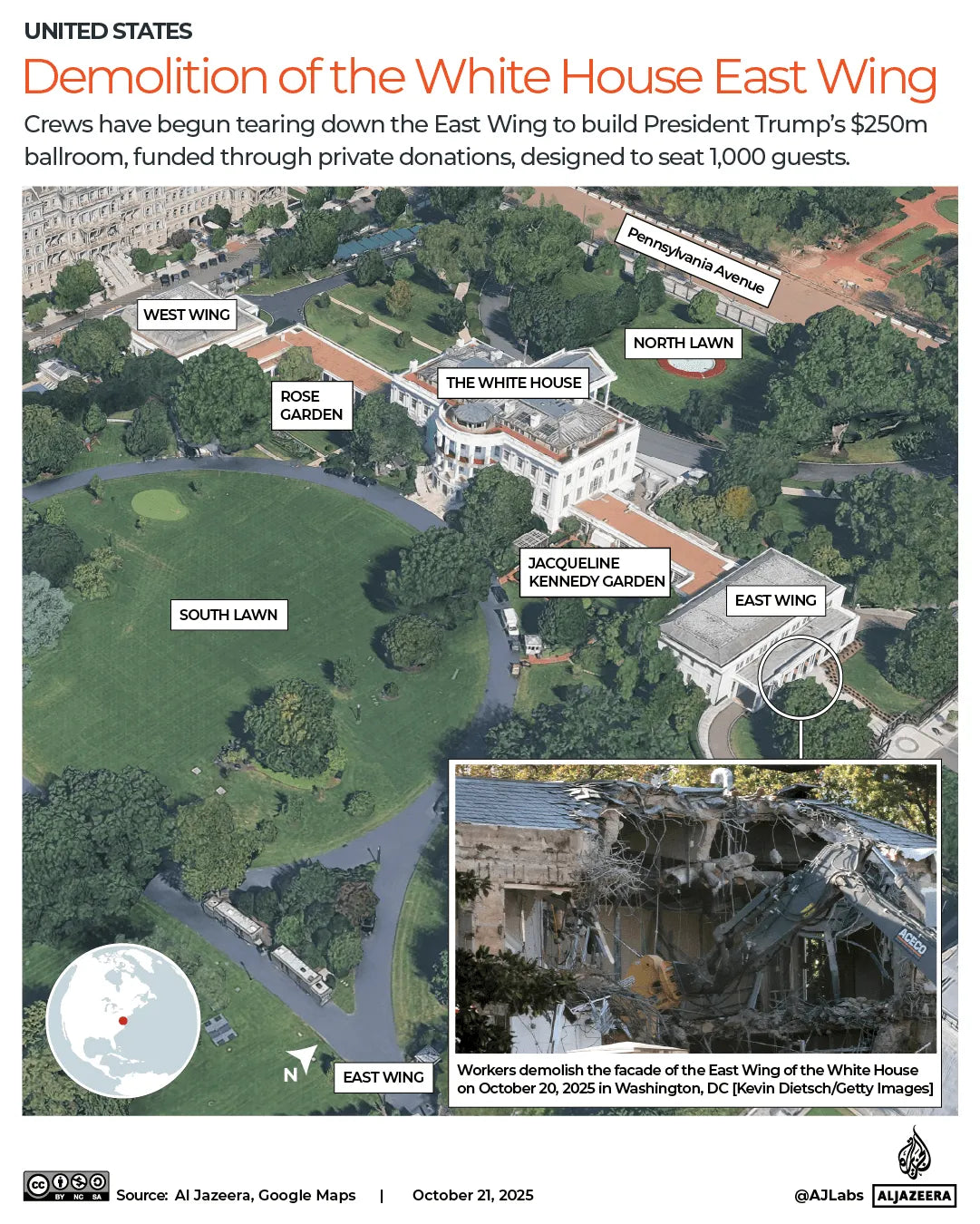In a move blending presidential pomp with long-overdue practicality, President Donald J. Trump has greenlit the demolition of the White House’s East Wing to pave the way for a sprawling 90,000-square-foot ballroom.
Announced in July 2025 and breaking ground in September, this $250 million project—fully funded by private donors including tech giants like Alphabet and contributions from the president himself—promises to transform how America hosts its global stage.
As construction crews tore into the East Wing’s facade this week, amid a federal government shutdown no less, the initiative has sparked fierce debate. Yet, beyond the headlines of “desecration” from critics, this renovation stands as a symbol of enduring investment in our nation’s prestige, even as we grapple with a ballooning $38 trillion national debt.
For decades, the White House has managed its glittering state dinners and diplomatic galas with a workaround that feels more like a backyard barbecue than a beacon of power: temporary tents erected on the South Lawn. The East Room, the residence’s largest interior space, seats just 200 for dinner—adequate for intimate gatherings but woefully inadequate for the summits and soirees that define modern diplomacy.
Enter the tents: climate-controlled pavilions with crystal chandeliers, Persian rugs, and heated floors, costing upwards of $1 million each time they’re deployed, not including setup, staffing, and weather contingencies.
Presidents from Barack Obama to Joe Biden have relied on them for major events—Obama’s dinners for Indian Prime Minister Narendra Modi and African leaders, Biden’s receptions for French President Emmanuel Macron—all unfolding under canvas amid the risk of D.C.’s unpredictable rains or sweltering summers. Trump himself long decried this as “not a pretty sight,” a sentiment he voiced as far back as 2010 to Obama’s advisor David Axelrod, offering to foot $100 million for a proper fix.
The new ballroom flips this script. Spanning nearly double the size of the main White House structure, it will accommodate up to 999 guests in a glass-walled marvel echoing the gilded elegance of Trump’s Mar-a-Lago estate—think soaring ceilings, intricate moldings, and space for orchestras, cocktail hours, and full-course feasts without a single zipper in sight.
No longer will foreign dignitaries like NATO Secretary General Mark Rutte or trade partners from the EU huddle under tarps; instead, they’ll glide through a permanent venue designed for permanence and prestige. This isn’t just about aesthetics—it’s about efficiency. The ballroom will host everything from state dinners to inaugural balls, potentially saving millions annually on tent rentals while projecting American innovation to the world. Imagine a G7 summit or a U.N. reception unfolding indoors, rain or shine, fostering deals that boost jobs and security. In an era of hybrid threats and economic rivalries, such a space reinforces the White House as the ultimate diplomatic powerhouse.
Of course, no discussion of grandeur can ignore the elephant—or rather, the $250 million price tag—in the room. Critics, including preservationists from the Society of Architectural Historians, decry the East Wing’s demolition as an “utter desecration” of a 1902 landmark, arguing it overwhelms the iconic mansion’s silhouette.
And with the U.S. debt clock ticking past $38 trillion this month—roughly $111,000 per citizen—the timing feels tone-deaf amid unpaid federal workers and shuttered services.
Even former First Lady Hillary Clinton piled on, firing up her social media followers with a viral post: “It’s not his house. It’s your house. And he’s destroying it.”
Clinton, whose own tenure saw modest upgrades like enhanced security under her husband Bill, framed the project as Trump’s personal playground, a gaudy overreach in gold leaf and excess.
But here’s the case for why it’s worth every privately sourced penny: long-term value. Unlike the Truman-era gutting in 1948 that stabilized the crumbling residence for generations, or the Obama-era Wi-Fi rollout, this ballroom addresses a chronic bottleneck in White House operations.
Experts like former White House chef Martin Mongiello, who served seven administrations, note that repeated tent setups rack up ancillary costs—logistics, security sweeps, even floral imports—that a fixed venue eliminates.
Over decades, it could pay for itself through streamlined events and heightened tourism appeal, drawing millions to “the People’s House” as a living testament to American ambition. Preservation? The design nods to classical heritage, led by firms like Clark Construction and AECOM, ensuring the ballroom complements rather than competes with the original structure.
Trump’s team insists it’ll be finished by 2029, a legacy gift to future presidents—Democrat or Republican—who won’t scramble for space during crises or celebrations.
That said, fiscal responsibility demands balance. We’re not just $38 trillion in the red; interest payments alone now devour over $1 trillion yearly, crowding out investments in infrastructure, defense, and debt reduction.
This ballroom, laudably off the taxpayer ledger, underscores the need to slash elsewhere: trim bloated bureaucracies, audit entitlements for waste, and enforce spending caps that have eluded Congress for years. But the real culprit in our debt spiral? The Federal Reserve’s unchecked money-printing machine. Since its founding in 1913, the Fed’s fiat policies have eroded the dollar’s purchasing power by over 96%—a silent tax on every American saver and wage earner. Inflation isn’t an act of God; it’s the byproduct of unelected bankers flooding the system with trillions, as seen in the post-2008 and COVID-era bailouts.
To rein this in, it’s time for bold reform: elect Federal Reserve Board members, subjecting them to voter accountability like any public servant. Imagine governors and the chair facing ballot scrutiny every four years, tethered to mandates for sound money—perhaps even a return to gold-standard audits. This isn’t radical; it’s restorative, echoing the Founders’ wariness of centralized banking. With elected oversight, endless quantitative easing would face the people’s judgment, curbing inflation’s theft of prosperity and stabilizing the dollar for families from coast to coast. Paired with cuts to redundant agencies and pork-barrel projects, such changes could claw back trillions, ensuring treasures like the White House ballroom enhance our future without bankrupting it.
As hammers echo across Pennsylvania Avenue, this renovation isn’t mere vanity—it’s a calculated bet on America’s enduring allure. Hillary Clinton may seethe, tents may gather dust, and debts may loom large, but by prioritizing permanence over patches and accountability over autonomy, we chart a course toward solvency and splendor. The People’s House deserves no less.










Share:
Trump Vows to Withdraw Israeli Funding Over West Bank Annexation Threat
The Hidden Dangers in Your Protein Shake: Why Real Food Should Be Your First Choice